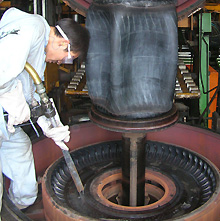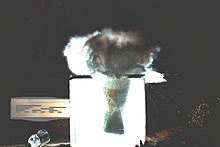
Making dry ice is easier than you thought! All you need is a pillow case, some gloves and a fire extinguisher. Watch below!
Dry ice, sometimes referred to as "cardice" (chiefly by British chemists), is the solid form of carbon dioxide. It is used primarily as a cooling agent. Its advantages include lower temperature than that of water ice and not leaving any residue (other than incidental frost from moisture in the atmosphere). It is useful for preserving frozen foods where mechanical cooling is unavailable.
Dry ice sublimates at −78.5 °C (−109.3 °F) at Earth atmospheric pressures. This extreme cold makes the solid dangerous to handle without protection due to burns caused by freezing (frostbite). While generally not very toxic, the outgassing from it can cause hypercapnia (abnormally elevated carbon dioxide levels in the blood) due to buildup in confined locations.
Industrial[edit]
Dry ice can be used for loosening asphalt floor tiles or car sound deadening material making it easy to prise off,[28] as well as freezing water in valveless pipes to enable repair.[29]
One of the largest mechanical uses of dry ice is blast cleaning. Dry ice pellets are shot from a nozzle with compressed air, combining the power of the speed of the pellets with the action of the sublimation. This can remove residues from industrial equipment. Examples of materials removed include ink, glue, oil, paint, mold and rubber. Dry ice blasting can replace sandblasting, steam blasting, water blasting or solvent blasting. The primary environmental residue of dry ice blasting is the sublimed CO2, thus making it a useful technique where residues from other blasting techniques are undesirable.[30] Recently, blast cleaning has been introduced as a method of removing smoke damage from structures after fires.
Dry ice is also useful for the de-gassing of flammable vapours from storage tanks — the sublimation of dry ice pellets inside an emptied and vented tank causes an outrush of CO2 that carries with it the flammable vapours.[31]
The removal and fitting of cylinder liners in large engines requires the use of dry ice to chill and thus shrink the liner so that it freely slides into the engine block. When the liner then warms up, it expands, and the resulting interference fit holds it tightly in place. Similar procedures may be used in fabricating mechanical assemblies with a high resultant strength, replacing the need for pins, keys or welds.[32]
Dry-ice blasting, a form of carbon dioxide cleaning, is used in a number of industrial applications.
It is also useful as a cutting fluid.
Scientific[edit]
In laboratories, a slurry of dry ice in an organic solvent is a useful freezing mixture for cold chemical reactions and for condensing solvents in rotary evaporators.[33] Dry ice/acetone forms a cold bath of −78 °C, which can be used for instance to prevent thermal runaway in a Swern oxidation.
The process of altering cloud precipitation can be done with the use of dry ice.[34] It was widely used in experiments in the US in the 1950s and early 60s before it was replaced by silver iodide.[34] Dry ice has the advantage of being relatively cheap and completely non-toxic.[34] Its main drawback is the need to be delivered directly into the supercooled region of clouds being seeded.[34]
Dry ice bombs[edit]
Main article: Dry ice bomb
A "dry ice bomb" is a balloon-like device using dry ice in a sealed container such as a plastic bottle. Water is usually added to accelerate the sublimation of the dry ice. As the dry ice sublimes, pressure increases, causing the bottle to burst causing a loud noise that can be avoided when a #3 rubber stopper replaces the screw on cap to make a Water rocket with a Two-liter bottle.
The dry ice bomb device was featured on MythBusters, episode 57 Mentos and Soda, which first aired on August 9, 2006.[35] It was also featured in an episode of Time Warp, as well as in an episode of Archer.
Extraterrestrial occurrence[edit]
Following the Mars flyby of the Mariner 4 spacecraft in 1966, scientists concluded that Mars' polar caps consist entirely of dry ice.[36] However, findings made in 2003 by researchers at the California Institute of Technology have shown that Mars' polar caps are almost completely made of water ice, and that dry ice only forms a thin surface layer that thickens and thins seasonally.[36][37] A phenomenon named dry ice storms was proposed to occur over the polar regions of Mars. They are comparable to Earth's thunderstorms, with crystalline CO2 taking the place of water in the clouds.[38]
In 2012, the European Space Agency's Venus Express probe detected a cold layer in the atmosphere of Venus where temperatures are close to the triple point of carbon dioxide and it is possible that flakes of dry ice precipitate.[39]
Safety[edit]
Prolonged exposure to dry ice can cause severe skin damage through frostbite, and the fog produced may also hinder attempts to withdraw from contact in a safe manner. Because it sublimes into large quantities of carbon dioxide gas, which could pose a danger of hypercapnia, dry ice should only be exposed to open air in a well-ventilated environment.[28]For this reason, dry ice is assigned the S-phrase S9 in the context of laboratory safety. Industrial dry ice may contain contaminants that make it unsafe for direct contact with foodstuffs.[40] Tiny dry ice pellets used in dry ice blast cleaning do not contain oily residues.
Although dry ice is not classified as a dangerous substance by the European Union,[41] or as a hazardous material by the United States Department of Transportation for ground transportation, when shipped by air or water, it is regulated as a dangerous good and IATA packing instruction 954 (IATA PI 954) requires that it be labeled specially, including a diamond-shaped black-and white label, UN 1845. Also, arrangements must be in place to ensure adequate ventilation so that pressure build-up does not rupture the packaging.[42] The Federal Aviation Administration in the US allows airline passengers to carry up to 2.5 kg per person either as checked baggage or carry-on baggage, when used to refrigerate
perishables.[43]
Uber-facts









0 comments:
Post a Comment